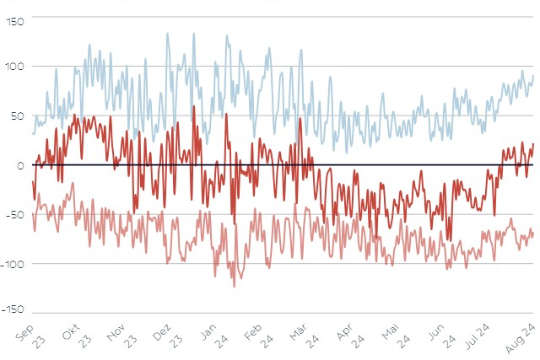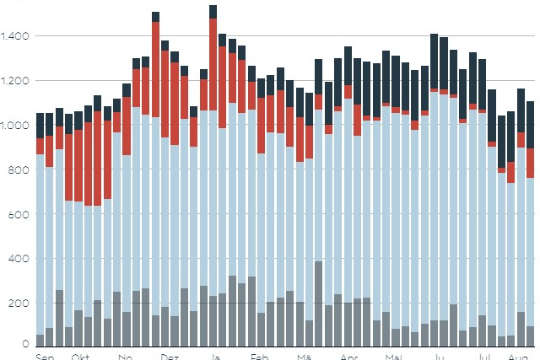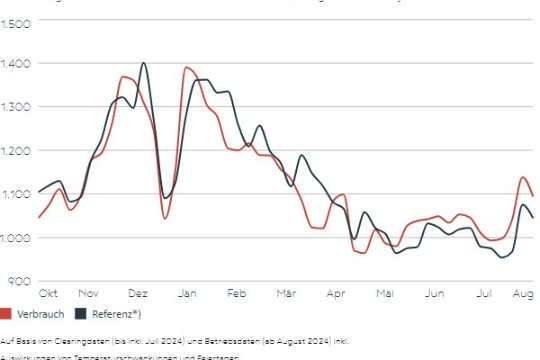APG: Austria is electricity importer in August for the first time in 2024
The APG factbox in August shows a decrease in renewable production in the month-on-month and year-on-year comparison. This means that exports decreased and that on balance, for the first time in 2024, Austria had to import more electricity than it was able to export.
August (calendar weeks 31-35) saw a slight decline in renewable production in Austria (APG control area). A total of 5,192 gigawatt hours (GWh) of electricity was produced from renewable energy sources in August, covering around 99% of Austria's electricity consumption (5,263 GWh). At 3,635 GWh, hydropower contributed around 70 percent of the renewable production. Compared to August 2023, this is around 20 percent less, mainly due to the extremely dry and hot weather in August. Wind power produced 459 GWh of electricity in August, which is a decrease of 19% compared to the previous year. Due to their massive expansion, PV systems contributed 967 GWh of electricity, which is an increase of 167% compared to the previous year.
The decrease in renewable production meant surplus electricity could be exported on only 12 days in August. On balance, a total of 30 GWh of electricity was imported, which means the imbalance was not very big.
No energy transition without a strong electricity grid
A strong grid is necessary to make the volatile, renewable electricity available and to transport it to where it is needed. To avoid grid overloads and ensure a secure supply, the electricity flow is managed with so-called redispatch measures, i.e. the targeted and controlled use of specific power plants.
In August interventions in the schedule of power plants in Austria were necessary on 19 days to ensure the security of the electricity supply. This is 1.4 days more than the average of the previous seven months (17.6 days per month in 2024). These interventions cause costs that eventually have to be borne by the electricity customers. In August these costs amounted to approx. 13.6 million euros.
A negative effect in addition to the costs and rising CO2 consumption is the "curtailment" of renewable power plant production: For example, wind power plants or run-of-river power plants that would be producing electricity at a certain time are shut down to avoid overloads in the electricity grid. Since the beginning of the year, an average of around 5,160 MWh of electricity per month has been "lost" due to these measures (the corresponding figure for August was around 720 MWh of electricity; the total from January to August was around 41,282 MWh).
“The installed potential output of renewable electricity is of no use to us if the infrastructure required to distribute the electricity is too weak or non-existent. The targeted use of thermal and hydraulic power plants, as well as the curtailment of renewables to prevent grid overloads, must be both a warning signal and a wake-up call: without a high-capacity and reliable electricity grid, we will not be able to achieve the energy industry’s goals that are necessary for a secure energy transition and at the same time we will experience increasingly negative economic effects”, emphasizes Christoph Schuh, APG’s company spokesperson.
A high-capacity electricity infrastructure, storage facilities, and digital intelligence within the electricity system are necessary to fully capitalize on the planned growth rates of renewables in the coming years. APG's EUR 9 billion investment scheme up to 2034 and its timely implementation is therefore key for achieving the energy transition without jeopardizing the security of supply. The simplification and acceleration of approval procedures are indispensable preconditions in this context.
This year alone, APG is investing EUR 445 million. Key projects include the completion of the Salzburg line, numerous substation projects in Upper and Lower Austria, the general renewal of the Enns Valley line (Ennstalleitung), and the completion of the Nauders substation with the Passo di Resia line (Rechenpassleitung) (www.apg.at/stromnetz/netzausbau/netzentwicklungsplan-2023/)
Energy exchange within Austria
The trans-regional electricity grid of APG facilitates the exchange of energy within the country. Electricity surpluses in individual provinces can thus be distributed throughout Austria to compensate for deficits.
Due to the good production of hydropower, the provinces Tyrol (360 GWh) and Upper Austria (311 GWh) generated the highest energy surplus in July and made it available throughout Austria via the APG grid. Vienna (490 GWh) and Carinthia (165 GWh) had to draw the most electricity from the grid.
Responsible energy consumption
The available data shows that 5,263 GWh of electricity from the public grid were consumed in Austria in August (calendar weeks 31-35) – this is around five percent more than in August 2023 (5,015 GWh).
It is important to act responsibly when it comes to electricity consumption. Saving electricity reduces CO2 and overall systemic costs, which are significant contributions to increasing system security. The trend of reducing CO2 has to be pushed further. This also includes electricity from private PV units.
Tips for saving electricity can be found at www.apg.at/stromspartipps. With the APG Powermonitor, the Austrian population can see the most effective electricity-saving hours and thus make an active contribution to CO2 reduction and system security. The APG Powermonitor can be found at: www.apg.at/powermonitor.
APG continually keeps track of the development of the domestic electricity industry and regularly publishes diagrams at https://www.apg.at/infografiken regarding the topics: energy exchange, energy consumption in Austria, renewables production, import/export, electricity prices, etc.
Click here for the current infographics
About Austrian Power Grid (APG)
As independent transmission system operator Austrian Power Grid (APG) is in charge of ensuring the security of the electricity supply in Austria. With our high-performance and digital electricity infrastructure and the use of state-of-the-art technologies we integrate renewable energies, we are the platform for the electricity market, and we provide access to reasonably priced electricity for Austria’s consumers and thus create the basis for Austria as supply-secure and future-oriented industrial and business location and place to live. The APG grid totals a length of about 3,400 km and is operated, maintained, and continuously adapted to the increasing challenges of the electrification of businesses, industry, and society by a team of approximately 900 specialists. 67 substations are distributed all over Austria and the majority is operated remotely from APG’s control center in Vienna’s 10th district. Thanks to our committed employees Austria had a security of supply of 99.99 percent also in 2023 and thus ranks among the top countries worldwide. Our investments of 445 million euros in 2024 (2023: 490 million euros, 2022: 370 million euros) are a motor for the Austrian economy and a crucial factor in reaching Austria’s climate and energy targets. Until 2034 APG will invest a total of approximately 9 billion euros in grid expansion and renovation projects.
Press contact
Christoph Schuh



